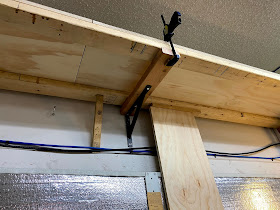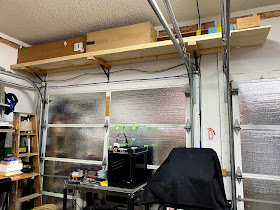Big changes up front
ODYSSEY Extreme Series batteries employ dry cell Absorbed Glass Mat (AGM) technology to contain acid, allowing the battery to be installed even on its side (but not upside down).
But, are two AGM small batteries better than one bigger one?
 |
| Two Odyssey PC680 taking up all of the nose space |
 |
| One Odyssey PC925 on its side taking up less room |
First of all, an original per-plans Long EZ does not need two batteries, but offsetting the bigger, heavier engine JT has in the back requires a certain additional amount of weight in the front to keep things in balance. Now, this can be useless weight like bags of lead shots, or useful weight like an extra battery.
Which one would you choose?
Yeah, I thought so!
Switching to the bigger battery removed 5.2 lb (2.4 kg) from the nose, and created some space for carrying a small toolkit.
 |
| Small but heavy |
 |
| Lighter but of equal capacity |
Because I do need the weight up front, I will create a toolkit that will put back at least 5 lb in the nose of the plane.
Did I really change anything then?
You see, while it would appear like an overall wash, those tools will come from the toolkit I normally carry in the passenger compartment when I go on trips, so this mod will save actual weight, and create a little more comfort for the back seater who won’t have to deal with a bag between his feet.
Had this been the only reason for the change, it would not have been very high on my priority list. Truth is, two batteries have a few drawbacks as well, and after killing one of my PC680s early in my JT experience, I was schooled by the Odyssey engineers on the proper way to charge a two-battery setup… which is across the two batteries.
 |
| Note how the charger leads connect to separate batteries |
In theory when you parallel two batteries (same kind and brand new) and your charging point is on the first battery, the charge would go to both, but apparently minor differences in the internal resistance of the batteries and cables used, will create a situation where the second (and third, and fourth) battery charges less over time, and its usefulness is reduced.
In reality, the battery connected directly to your charger will draw more amperage than the battery furthest down the bank, as the current is reduced through each interconnecting lead.
When this happens, the downstream battery is always less charged, and starts to “go bad” beginning to act like a vampire or black hole on the electrical system, sucking precious charge from the good one. This creates a situation where the two-battery setup is never fully charged, and two small batteries become less effective than even a single small battery.
Next thing you know, over time the engine becomes harder to start, and that’s because your one good battery is not only carrying starting loads, but it is actually fighting battery #2 at the same time.
Ask me how I found that out!
Once again, the proper way to charge two batteries is across them.
 |
| Both batteries drawing equal current |
But even then, your results might vary based on the age of each battery, whether it is of the same kind, etc.
Because of the extra attention one has to pay to the second battery, I decided to move away from the dual setup, and simplify my installation by using just one big battery.
 |
| Using duct tape to protect the battery, and adding some clearance to the battery tray-to-be. |
 |
| Using Bid leftovers for this project |
 |
| Glassed and peel-plied |
 |
| Tray removed |
Turns out the tray was a bit flimsy, so I added a few more plies to stiffen it up.
 |
| Thicker tray fits perfectly over the battery |
 |
| This battery can be installed in any orientation but upside down |
 |
| Light and sturdy, but how to attach it to the plane? |
 |
| The new battery fits great on its side |
 |
| Some of the old tie-down hardware will have to be removed |
 |
| I decided to keep the front fiberglass tab as it's in the perfect spot to help me glass the tray |
 |
| This is where I'll mount the tray |
Having decided where to mount the tray, the next step was deciding how attach it to the floor of the nose, and how to hold the battery down.
Initially I leaned toward glassing the whole interior of the tray directly to the floor...
 |
| Initial glassing plan |
... and make some sort of integral fiberglass hold down, with aluminum hinges, pins, etc...
 |
| Tie-down ideas from my buddy Wade |
... but then I ran into a battery tie-down strap from a local boating accessories store for only $5!!!
 |
| 3" by 36" nylon strap and buckle are resistant to acid spills and corrosion |
Less glass, less weight, less money, less... work!
I had to make this happen!
The plan changed slightly to leave a fiberglass-free zone in the middle for the strap to pass through.
 |
| New glassing plan |
 |
| Checking for clearance |
 |
| $5 battery hold down strap from West Marine (boating accessories) |
 |
| Gaining any amount of space in such a tight plane is akin to finding gold! |
 |
| Too tight for power tools in here, all sanding had to be done the old fashioned way. |
 |
| "No, I never throw away old newspapers!" |
 |
| Battery tray glassed and peel-plied curing under the heat lamp |
 |
| Temperature was closely monitored at all times |
 |
| Plastic sheet under aluminum tape to minimize difficult cleanup |
|
 |
| Peel ply, tape, and plastic removed. |
|
 |
| Passthrough channel for strap remained clear of glass and epoxy 👍🏻 |
 |
| After a little cleanup |
 |
| Perfect fit! |
 |
| Job's done! |
 |
Much simpler battery wiring
|
 |
| New found space put to good use |
Nothing left to do now but to test it.
😉
Let's go flying!




















































































